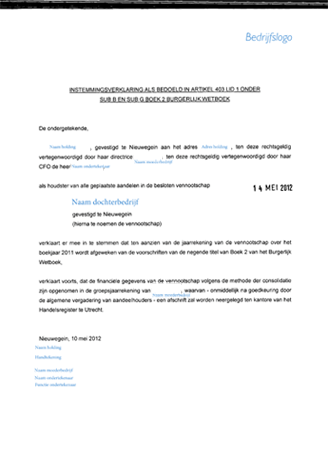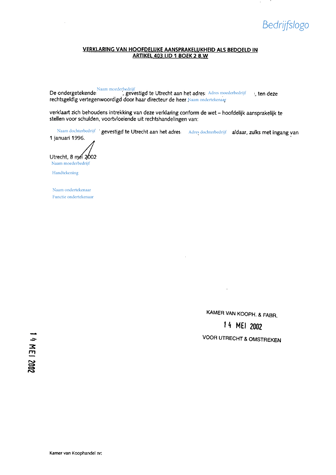‘Do you know how to request a 403 certificate?’ was something one of my colleagues asked me the other day. I had to shamefully admit I had no inkling what a 403 request even was. Let alone how to request one.
After a bit of Google research I discovered that behind this small concept there lurks a whole world of confusion. I suddenly found myself in the world of the legal profession. And it is there that, to use the words of Herman Finkers: ‘Even one misplaced punctuation mark or letter turns Jesus into a heretic.’.
On the exact reach and reasons for the composing a 403 certificate I will write a blog in the future. In this blog I wish to focus on the question of my colleague: ‘How do I request a 403 certificate?’.
What is a 403 certificate?
Before I show you how to request this 403 certificate I will a moment to describe the situation, but I will do so in a nutshell.
By law, all companies, except, generally, companies with sole proprietors, general partnerships and limited partnerships (according to the current legal structure), should file a financial statement with the chamber of commerce.
However, there are some exceptions. One of these exceptions to the disclosure requirement is when a company meets the demands as set in article 403:2 BW. In this article some demands are listed that a company must meet before being exempt from this disclosure requirement.
For example, the parent company needs to include the annual numbers of the subsidiary in its annual report and with that publish a so-called consolidated annual account.
However, now that the subsidiary no longer publishes an annual account it is very difficult for potential suppliers (and of course customers) to estimate how risky it is to do business with this company. To compensate for the requirements of these companies one of the other demands of article 403:2 BW is that the parent company needs to guarantee the subsidiary. This is popularly called a 403 certificate.
The guarantee from a parent company for a subsidiary consists of two documents, which are:
Liability certificate
In full, this certificate is officially called ‘Liability certificate as meant in article 403, paragraph 1.f, book 2 of the Dutch Civil Code’. This is what most people think of when they mention a 403 certificate. Article 403:2 BW mentions the following here:
'the legal entity or company referred to in c has declared written joint and several liability for the legal debts and obligations arising from legal acts of the legal person; and’
In paragraph 1 under c the following can be read:
the financial data of the legal entity by another legal entity or company are consolidates in a consolidated annual account which applies under the applicable law of the Regulation of the European Parliament and of the Council on the application of international accounting standards, the Seventh Council Directive of the European Communities on the corporate law or one of the two Council Directives of the European Communities on the annual accounts and consolidated accounts of banks and other financial institutions or of insurance undertakings;’
Ergo, in the liability certificate the parent company declares to guarantee for the legal acts of the subsidiary starting from a certain date. This liability certificate needs to be deposited one by the parent company at the Chamber of Commerce.
Consent certificate
Its full name is ‘consent certificate as referred to in Article 403, paragraph 1, under b, Book 2 of the Civil Code’. This reads the following:
‘the members or shareholders have declared to agree in writing with the derogation from the requirements after the beginning of the fiscal year and before the determination of the annual account;’ This is a lesser known part of this guarantee and is often forgotten when people talk about a 403 certificate. The subsidiary also needs to indicate that it is accepted that the parent company guarantees for the company. The subsidiary needs to deposit this annually at the Chamber of Commerce.
There is no clear format for the consent certificate and liability certificate. Unlike many documents that can be requested at the Chamber of Commerce, there is no fixed form or example for composing a 403 certificate that a company only has to put a signature to.
However, what is usually established in the liability certificate are the following matters:
Effective Date
It is important to mention the effective date of the certificate. The certificate is valid commencing from that moment. Should this not be mentioned then the law says that the date of deposit is counted as effective date.
Extent of liability
Here the parent company can indicate what is exactly guaranteed under this liability. In article 2:403 BW it is said that the company assumes joint and several liability for 'the legal debts arising from legal acts of the legal entity. Again, the Civil Code says the following:
'the legal entity or company referred to in c has declared written joint and several liability for the legal debts and obligations arising from legal acts of the legal person; and’
It can thus be concluded that debts from for example tort and tax debt do not usually fall under this liability. That is because these are debts originating from the law.
To clarify this somewhat I have added an example of a deposited liability certificate and consent certificate further in the text that I have requested at the Chamber of Commerce.
Now that I have explained what the 403 certificate is and what its requirements are I will explain to you how to request a 403 certificate.
How do I request a 403 certificate?
The reason for you being on this blog are most likely that you are one of the suppliers or customers of a company with a 403 certificate. But how and where do you request a 403 certificate?
As has been mentioned before both the parent company and the subsidiary, to meet all the rules concerning the 403 certificate, need to deposit a certificate at the Chamber of Commerce. Of course this can then also be requested at the Chamber of Commerce.
After a call to the Chamber of Commerce it turns out that this deposited consent certificate and liability certificate can unfortunately not yet be requested through the Chamber of Commerce. Currently the requesting of the certificates related to a 403 certificate can only be done by telephone. However, you can see on the website whether a certain company has deposited these certificates.
When it comes to requesting a 403 certificate you simply complete the following actions:
Determine whether the company has a liability and consent statement.
-
Before you call the Chamber of Commerce to request a 403 certificate it is useful to discover whether your relation has even deposited the 2 certificates. If you already know this then you can of course skip this step.
-
Go to the website of the Chamber of Commerce and search for the relation of which you would like to request the certificates.
-
Click on the page of this company on the button ‘Deposits’ and follow the payment instructions of the Chamber of Commerce. Here you can also find other deposited pieces or you can see if the company has deposited the correct certificates to meet the demands for a 403 certificate. An example of the overview you might receive can be found here.
Has the company not deposited a consent and/or liability certificate? Then you should check to see if they are making use of the arrangement as indicated in article 2:403 BW. If they are doing so, but have not deposited the certificated then they are in violation of the law and it might be wise to reconsider the decision to do business with this relation.
Have they even deposited these certificates? Then continue with the following steps.
!pro tip! You of course need to figure out on your own whether the companies have deposited the consent and/or liability statements, but if you proceed to step two right away the employee from the Chamber of Commerce can look this up for you as well. This saves some time, and of course costs of the ‘deposited pieces’ overview.
Requesting the 403 certificate.
-
Note the Chamber of Commerce number and full name of both the subsidiary and the parent company. Officially you only need the data of the subsidiary, but you can never know if it might come in useful nonetheless.
-
Contact the Chamber of Commerce through the telephone number +31 34 84 26 276, and choose for option 1.
-
You will now get an employee of the Chamber of Commerce on the telephone. This person will ask which documents you wish to request. Explain that you would like to request the documents belonging to a 403 certificate. You will be asked for the Chamber of Commerce number of the subsidiary. With this data the employee will locate the documents and send them to you.
Fortunately, it is already possible at this time to receive the consent certificate and liability certificate by e-mail. Should the employee forget to offer this to you, you should ask for it. Unfortunately the invoice can only be send by mail currently.
Some time later, it took about half an hour in my case, you will receive the documents by mail.
Below you can see a copy of the liability certificate and approval certificate that I requested. I have of course made the data of the concerning company unrecognizable, but it does give you an image of how the liability certificate and consent certificate as referred to in article 504:2 BW should look. You can click on the images for a larger version.
Copy of a registered liability statement

Copy of a registered consent certificate

To summarize once more
A 403 certificate basically consists of 2 elements. The liability certificate, which means that the parent company guarantees for the subsidiary. And the consent certificate, which states that the subsidiary accepts this. For the subsidiary, the disclosure requirement for the annual report is voided because of this. However, to meet the requirements of customers and suppliers, the parent company must include the annual figures of the subsidiary in its annual report, which is the so-called ‘consolidated annual report’.
Everyone can request the 2 certificates belonging to a 403 certificate at the Chamber of Commerce. This has to be done by telephone, but the documents can be received digitally. All you need for this is the Chamber of Commerce number of the subsidiary company.
As said before I will delve deeper into the legal aspect of a 403 certificate in a subsequent blog.
I hope to have answered all questions in this blog concerning the request of a 403 certificate. If you have questions or a story on your experiences with the 403 certificate then I invite you to leave those in the comments.